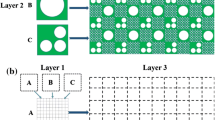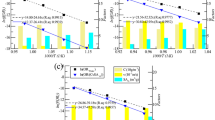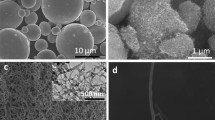Abstract
NG-CT-10 and NG-CT-20 are newly developed grades of nuclear-grade graphite from China. In this study, their oxidation behaviors were experimentally investigated using thermal gravimetric analysis. Microstructural evolution before and after oxidation was investigated using scanning electron microscope, mercury intrusion, and Raman spectroscopy. The apparent activation energy of NG-CT-10 nuclear graphite is 161.4 kJ/mol in a reaction temperature range of 550–700 °C and that of NG-CT-20 is 153.5 kJ/mol in a temperature range of 550–650 °C. The activation energy in the inner diffusion control regime is approximately half that in the kinetics control regime. At high temperatures, the binder phase is preferentially oxidized over the filler particles and small pores are generated in the binder. No new large or deep pores are generated on the graphite surfaces. Oxygen can diffuse along the boundaries of filler particles and through the binder phase, but cannot diffuse into the spaces between the nanocrystallites in the filler particles. Filler particles are oxidized starting at their outer surfaces, and the sizes of nanocrystallites do not decrease following oxidation.









Similar content being viewed by others
References
Z. Zhang, Z. Wu, D. Wang et al., Current status and technical description of Chinese 2 × 250 MWth HTR-PM demonstration plant. Nucl. Eng. Des. 239, 1212–1219 (2009). https://doi.org/10.1016/j.nucengdes.2009.02.023
Z. Zhang, Y. Dong, F. Li et al., The Shandong shidao bay 200 MWe high-temperature gas-cooled reactor pebble-bed module (HTR-PM) demonstration power plant: an engineering and technological innovation. Engineering 2, 112–118 (2016). https://doi.org/10.1016/J.ENG.2016.01.020
Z. Zhang, Y. Dong, W. Scherer, Assessments of water ingress accidents in modular high temperature gas cooled reactor. Nucl. Technol. 149, 253–264 (2005)
C.I. Contescu, T. Guldan, P. Wang et al., The effect of microstructure on air oxidation resistance of nuclear graphite. Carbon 50, 3354–3366 (2012). https://doi.org/10.1016/j.carbon.2012.01.040
P. Wang, C.I. Contescu, S. Yu et al., Pore structure development in oxidized IG-110 nuclear graphite. J. Nucl. Mater. 430, 229–238 (2012). https://doi.org/10.1016/j.jnucmat.2012.07.015
C. Karthik, J. Kane, D.P. Butt et al., Microstructural characterization of next generation nuclear graphites. Microsc. Microanal. 18, 272–278 (2012). https://doi.org/10.1017/S1431927611012360
C. Zhang, Z. He, Y. Gao et al., The effect of molten FLiNaK salt infiltration on the strength of graphite. J. Nucl. Mater. 512, 37–45 (2018). https://doi.org/10.1016/j.jnucmat.2018.09.051
S. Jing, C. Zhang, J. Pu et al., 3D microstructures of nuclear graphite: IG-110, NBG-18 and NG-CT-10. Nucl. Sci. Tech. 27, 66 (2016). https://doi.org/10.1007/s41365-016-0071-0
H. Tang, W. Qi, Z. He et al., Infiltration of graphite by molten 2LiF–BeF 2 salt. J. Mater. Sci. 52, 11346–11359 (2017). https://doi.org/10.1007/s10853-017-1310-4
C. Zhang, H. Tang, Z.He et al., Dataset on the mechanical property of graphite after molten FLiNaK salt infiltration. Data Brief 21, 1963–1969 (2018). https://doi.org/10.1016/j.dib.2018.11.036
T. Shibata, J. Sumita, T. Tada et al., Non-destructive evaluation methods for degradation of IG-110 and IG-430 graphite. J. Nucl. Mater. 381, 165–170 (2008). https://doi.org/10.1016/j.jnucmat.2008.07.014
P.A. Thrower, G.K. Mathew, N.J. Mcginnis, The influence of oxidation on the structure and strength of graphite II: materials of different impurity content. Carbon 20, 457–464 (1982). https://doi.org/10.1016/0008-6223(82)90081-1
D.W. McKee, Metal oxides as catalysts for the oxidation of graphite. Carbon 8, 623–635 (1970). https://doi.org/10.1016/0008-6223(70)90055-2
T. Miyatani, H. Suzuki, O. Yoshimoto, Quantitative analysis of trace amounts of impurities contaminating pure graphite with ICP-MS and metal atomizer FLAAS. No. IAEA-TECDOC-690 (1993)
H.K. Hinssen, K. Kühn, R. Moormann et al., Oxidation experiments and theoretical examinations on graphite materials relevant for the PBMR. Nucl. Eng. Des. 238, 3018–3025 (2008). https://doi.org/10.1016/j.nucengdes.2008.02.013
E.L. Fuller, J.M. Okoh, Kinetics and mechanisms of the reaction of air with nuclear grade graphites: IG-110. J. Nucl. Mater. 240, 241–250 (1997). https://doi.org/10.1016/s0022-3115(96)00462-x
E.S. Kim, C.H. Oh, C.H. No, Experimental study and model development on the moisture effect for nuclear graphite oxidation. Nucl. Technol. 164, 278–285 (2008). https://doi.org/10.13182/NT08-A4026
X. Luo, J.C. Robin, S. Yu, Effect of temperature on graphite oxidation behavior. Nucl. Eng. Des. 227, 273–280 (2004). https://doi.org/10.1016/j.nucengdes.2003.11.004
S.H. Chi, G.C. Kim, Comparison of the oxidation rate and degree of graphitization of selected IG and NBG nuclear graphite grades. J. Nucl. Mater. 381, 9–14 (2008). https://doi.org/10.1016/j.jnucmat.2008.07.027
H.C. Yang, H.C. Eun, D.G. Lee et al., Analysis of combustion kinetics of powdered nuclear graphite by using a non-isothermal thermogravimetric method. J. Nucl. Sci. Technol. 43, 1436–1439 (2006). https://doi.org/10.1080/18811248.2006.9711238
P. Wang, S. Yu, Effects of gas flow rate and temperature on the oxidation rate of IG-110 nuclear graphite. J. Tsinghua Univ. (Sci. Tech.) 52, 504–547 (2012). https://doi.org/10.16511/j.cnki.qhdxxb.2012.04.032
X. Luo, J.C. Robin, S. Yu, Comparison of oxidation behaviors of different grades of nuclear graphite. Nucl. Sci. Eng. 151, 121–127 (2005). https://doi.org/10.13182/NSE05-A2534
D. Chen, Z. Li, M. Wei et al., Effects of porosity and temperature on oxidation behavior in air of selected nuclear graphites. Mater. Trans. 53, 1159–1163 (2012). https://doi.org/10.2320/matertrans.MBW201107
X. Sun, Y. Dong, Y. Zhou et al., Effects of reaction temperature and inlet oxidizing gas flow rate on IG-110 graphite oxidation used in HTR-PM. J. Nucl. Sci. Technol. 54, 196–204 (2016). https://doi.org/10.1080/00223131.2016.1233080
Z. Hu, Z. Li, D. Chen et al., CO2 corrosion of IG-110 nuclear graphite studied by gas chromatography. J. Nucl. Sci. Technol. 51, 487–492 (2014). https://doi.org/10.1080/00223131.2013.877407
S.H. Chi, G.C. Kim, Effects of air flow rate on the oxidation of NBG-18 and NBG-25 nuclear graphite. J. Nucl. Mater. 491, 37–42 (2017). https://doi.org/10.1016/j.jnucmat.2017.04.032
I. Childres, L. Jauregui, W. Park et al., Raman spectroscopy of graphene and related materials. New Dev. Photon Mater. Res. 1, 1–20 (2013).
A. Maslova, M.R. Ammar, G. Guimbretière et al., Determination of crystallite size in polished graphitized carbon by Raman spectroscopy. Phys. Rev. B 86, 134205 (2012). https://doi.org/10.1103/physrevb.86.134205
F. Tuinstra, J.L. Koenig, Raman spectrum of graphite. J. Chem. Phys. 53, 1126 (1970). https://doi.org/10.1063/1.1674108
K.Y. Wen, T.J. Marrow, B.J. Marsden, The microstructure of nuclear graphite binders. Carbon 46, 62–71 (2008). https://doi.org/10.1016/j.carbon.2007.10.025
Author information
Authors and Affiliations
Corresponding authors
Additional information
This work was financially supported by the National Natural Science Foundation of China (No. 51576103) and the National S&T Major Project (No. ZX06901).
Rights and permissions
About this article
Cite this article
Lu, W., Li, MY., Li, XW. et al. Experimental study on the oxidation behavior and microstructural evolution of NG-CT-10 and NG-CT-20 nuclear graphite. NUCL SCI TECH 30, 165 (2019). https://doi.org/10.1007/s41365-019-0693-0
Received:
Revised:
Accepted:
Published:
DOI: https://doi.org/10.1007/s41365-019-0693-0




